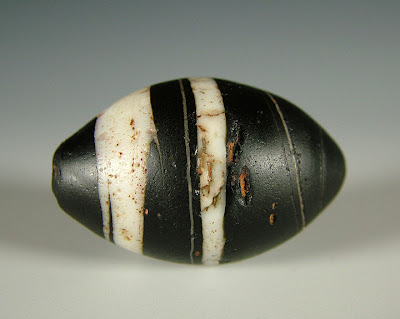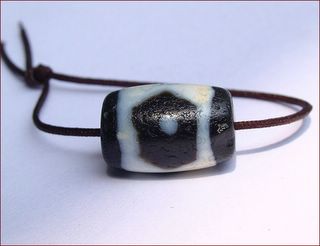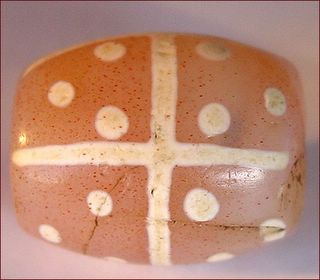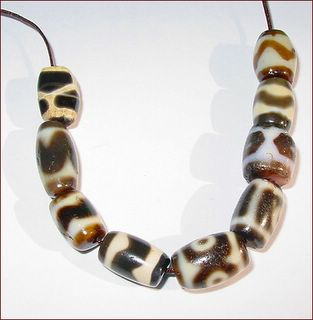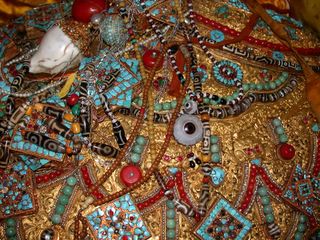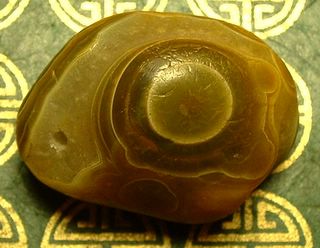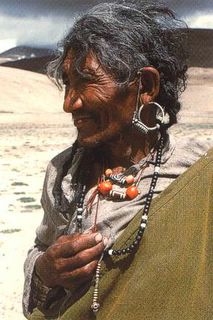Wednesday, November 09, 2005
Wednesday, July 27, 2005
Photo: Tibetan Thangka Painter
Tibetans have a very rich tradition of sacred iconography and paintings are known by the name 'Thangka'. The apprentice is expected to spend many years studying under a master artist. Some works can take several years to complete and are often painted with natural stone pigment paints. For that extra special touch, some artists will use a dZi bead to apply and burnish gold. The dZi is mounted like a brush on a wooden handle, which helps give the artist more precision. It is believed that Thangkas will carry a unique and luminous quality by using a dZi bead tool.
Above: Sangye Menla (Medicine Buddha)
Ancient dZi beads have been used in Tibetan medicine for centuries. Small shavings of whole dZi or broken fragments of dZi are ground up and mixed with other herbs and minerals. Pills (Tibetan: Rilbu) are then made and ingested to cure all manner of illness. Dzi medicine is thought to cure epilepsy, lower blood pressure and ward of harmful spirits.
Sunday, February 06, 2005
Friday, February 04, 2005
Ancient Carnelian Eye Beads
These beads were excavated in the City of Balh, Afghanistan. Similar beads have been found in the Indus Valley, Egypt and Iran. Although these beads are commonly known as 'etched' carnelian it is now known that no etching is involved. The beads were decorated by adding an alkali, soda or potash solution and then fired. The design was then able to penetrate the surface of the bead and leave the very distinctive white decoration against a background of fiery orang
Wednesday, February 02, 2005
The Value of dZi
Above: A rare ancient Phum dZi bead with eyes.
- Availablity.
There are relatively very few ancient dZi beads that come into the marketplace and this keeps the demand for these beads very high. They are cherished items and their owners will not readily part with them. If they are important heirloom beads they are even less likely to be sold.
- Rarity of Decorations.
The rarest decorations will command the highest prices. Also, certain types of dZi are more desirable than others. There will also be some designs that are rarely seen in the marketplace or have never been seen, and it is easy to become out of touch with true market prices if one spends little or no time traveling in Asia.
In the year 2000 you could purchase a reasonable two eyed dZi for somewhere between $1000 and $2000. In 2008 the best beads can command between $4000 and $12,000. Escalating prices make purchasing dZi difficult for the collector and it also becomes increasingly difficult for the dealers to acquire them. This is one of the many reasons that so many imitation beads are being sold. With demand so high and prices rising they are now out of reach of most collectors. Rocketing prices makes many believe that they are a very sound investment.
- Rarity of Size and Shape
Sunday, January 30, 2005
Homa Ritual
Ancient Sakor Namkor dZi
This Sakor Namkor dZi and similar beads with a distinct dullness, are commonly looked upon as fire offering beads (although it is still unproven). Homa is an ancient fire ritual which is said to stem from the vedic sciences and is still a very important practice for Hindus. Tibetans Buddhists practice their own form of fire puja, however, it is unconfirmed if dZi beads are ever used in these offerings. If a homa is performed correctly, it is believed to remove all manner of karmic obstacles. The decoration on burnt beads will usually have a greyish look and an appearance that does not reflect the light. They are still valued but they are usually less desirable in the Tibetan marketplace. It is also possible that these beads were overheated during their creation, but since Tibetans do not believe dZi are created by man they do not adopt this belief.
also see http://en.wikipedia.org/wiki/Homa_(ritual)
also see http://en.wikipedia.org/wiki/Homa_(ritual)
Damaged dZi
A widely held Tibetan belief is that a
damaged dZi bead has absorbed or averted a major catastrophe or protected the owner
from great negativity or misfortune. Although this dZi has been damaged it has continued to be worn and cherished by the owner. The damaged zone has been worn smooth from centuries of being worn on the body and has developed a smooth waxy patina from rubbing on the body and absorbing oils from the skin. It is a clear example of a bead that has not been discarded because of a breakage. The fact that the eyes remain completely damage free is what matters to the owner of this bead. Usually if a damaged dZi is worn then it is normally beads that have eyes intact or beads with unusual motifs that are preferred. Also, if the damaged bead has a strong colour then it is still believed to have amuletic power.
A damaged bead is often set into a ring or pendant if it is a suitable size. If broken, the two halves are often joined back together with a gold band or the ends are capped with gold to disguise the damage. Undamaged beads are rarely capped or framed with precious metal because they are considered more valuable and more potent if kept whole. Damaged dZi are also fashioned into a tool that can be used to apply gold to traditional Thangka paintings. Broken dZi fragments are also ground down and used in Tibetan Medicine.
A damaged bead is often set into a ring or pendant if it is a suitable size. If broken, the two halves are often joined back together with a gold band or the ends are capped with gold to disguise the damage. Undamaged beads are rarely capped or framed with precious metal because they are considered more valuable and more potent if kept whole. Damaged dZi are also fashioned into a tool that can be used to apply gold to traditional Thangka paintings. Broken dZi fragments are also ground down and used in Tibetan Medicine.
Friday, January 28, 2005
Damaged dZi
Above: An ancient four eyed dZi that unfortunately got damaged at some point in its history. Deep wear can be seen at the damaged end. This kind of wear happens after rubbing against other stone beads for possibly many hundreds of years - which indicates that this bead was worn and heirloomed even though it was damaged. It is clear that this dispels the myth that dZi are discarded when broken.
Tibetans believe that a damaged bead loses some of its power to protect the wearer. However, most Tibetans still feel there is benefit in wearing damaged beads as amulets. I have seen many Tibetan owned beads with old repairs and they are still highly valued. Broken beads are often given a new lease of life with careful restoration. Sometimes damaged beads are set into a statue, ring or pendant. Very few undamaged dZi would be set into jewellery if they still functioned as a wearable bead. Small barrel or oval shaped dZi are normally set into a gold saddle ring and are particularly fashionable with wealthy Tibetans.
Both damaged and undamaged dZi are used in Tibetan Medicine. Small shavings or chips are carefully taken from the body of the bead, and this is usually done near the perforations. A chip is never taken from an eye. It is believed that by offering a small shaving for medicinal use, you would accumulate a great deal of merit. "As Ye Sow, So Shall Ye Reap." In Tibetan medicine, dZi are used in the treatment of epilepsy and circulatory problems. It is also believed that they can regulate the heart and generally keep the body free from illness. Beads are usually ground up and mixed with other herbs and minerals to produce pills (Tibetan: Rilbu), which are then ingested.
Wednesday, January 26, 2005

Are ancient dZi still worn today?
Many Tibetans continue to wear their heirloom beads, however, the majority of Tibetans keep their beads under lock and key. This is because they are simply too frightened to have them on show in case they are robbed. Some of these beads now command thousands of dollars. I have heard of many people having their beads stolen in Tibet, Nepal and India. So most keep them hidden, either inside their clothing or in their homes. Walking around the Tibetan settlements in Nepal or India it is a joy to see the old Tibetans keeping their culture alive. Most young Tibetans have lost interest in this, and instead look to the bright lights of the west. This is a great shame!
The few beads that we do see on show are usually modern Taiwanese or Chinese replicas. These beads are affordable, from a distance they look like the real thing and there is less worry about them being stolen. Genuine dZi are usually seen on very special occasions and festivals.
The few beads that we do see on show are usually modern Taiwanese or Chinese replicas. These beads are affordable, from a distance they look like the real thing and there is less worry about them being stolen. Genuine dZi are usually seen on very special occasions and festivals.
Four Striped Chung with shavings or digs around the holes. This is an indication that this bead may have been used for medicinal purposes. Small shavings from the bead are ground down and mixed with other medicinal substances to produce pills (Tibetan: Rilbu). It is believed that if you offer small shavings for use in medicine then it will increase the power of your bead (not the value).
What is a dZi bead?
Above photo: Different types of
ancient dZi beads (Wylie: gZi)
ancient dZi beads (Wylie: gZi)
In Tibet and the Himalayan regions the word dZi (say zee) is the generic name for a large variety of ancient chalcedony, agate or carnelian stone beads. The vast majority of dZi beads have been heat treated to enhance the natural crystalline banding in the stone or to darken the material in preparation for applying the decorated lines. There are very few beads that can be classed as 'naturally occurring'. This is because at least some treatments were involved to darken or dye the stone, a process used by gemstone or lapidary workers for thousands of years. Contrary to popular belief, the name dZi is not only reserved for stone beads with eyes. This being said, it is probably the eye beads (including beads with unusual motifs) that are most widely recognised and accepted as being true dZi beads. Nevertheless, any ancient agate bead found within a Tibetan or Himalayan context can still be considered to be a type of dZi bead. If an ancient agate bead has been found in Thailand for example (clearly not within a Tibetan context), it would not necessarily be appropriate to call it a dZi bead.
A bead can only be considered to be truly ancient if it was created more than 1000 years ago. It is also important to recognise that not all ancient dZi beads were created during the same period or come from the same region. Some beads could pre-date others by as much as 3000 years and would have found their way to Tibet by traders and countless pilgrims passing along the silk road. Beads can also vary greatly in quality, shape, design and even the methods used to create them may differ. We must not forget that Tibetans strongly believe that true dZi beads are not created by human hands and this is one of the many reasons they are so highly valued. There are many varieties of dZi beads that can be found and their condition can vary greatly. This means that some types have become much more valuable than others.
The rarest dZi that display eyes and unusual motifs are often referred to as true dZi or 'pure' dZi and are easily distinguished from other beads. These beads are usually the most sought after, however, in the Himalayan regions dZi are always valued on their individual merits. For example, an exceptional Chong dZi (Wylie: mchong) can be much more desirable than a mediocre dZi bead with eyes. Also, some pure dZi may be comparable in quality to eye beads but display other types of decoration like a lotus or vase for example. The type and quality of decoration will therefore greatly contribute to the desirability of a bead and its use as an amulet.
Above: Tasso dZi (centre) flanked by Tiger dZi.
I personally group dZi into two main categories (see below), which is primarily based on how Tibetans view and trade dZi. Throughout the year I source dZi from a number of experienced Himalayan bead dealers and collectors who are mainly of Tibetan, Indian and Nepalese origin. This gives me a very clear understanding of how these beads are viewed in the different regions of the Himalayas. The categories below are also shaped by the current trends in desirability and market value. Collectors of dZi outside of the Himalayan regions have certainly influenced this in recent years.
Above: Ancient agate bead
(This agate bead has not been decorated, however, like most ancient
agate beads it has been treated to alter or enhance the colour)
What is Agate?
Agate is a common semi-precious silica mineral that has long been used as a gemstone ornament. Agate is the most common variety of chalcedony which is a form of quartz. Agate is, in fact, identical with quartz in composition and physical properties. Composed of silicon dioxide (SiO2), it has a hardness of 7, a glassy luster, a conchoidal fracture, and a specific gravity of 2.60. Agate obtains its typical banded appearance through the disposition of other substances and layers, and the bands may consist of the most varied representatives of the quartz group, chalcedony, carnelian, onyx and jasper.
Agate is prized in the Middle East and Asia as a protective amulet and general good luck stone. Apparently 'enhydro' agates (water agates) were also popular charms for pregnancy. The practice of decorating beads has been known since at least 2500 BCE in the Indus Valley and nearly all ancient agate beads have been treated in some way. More often than not these beads have been dyed by applying a sugar rich solution (Jamey D. Allen) and then fired to transform the colour. Light coloured agates would turn brown or black and the white concentric crystalline layers or 'eyes' would become more apparent. Thus making the bead much more visually attractive as an 'eye' amulet.
Category 1 is generally the most sought after group of beads (in order of desirabilty). It should be noted that dZi with eyes tend to be the most sought after of all dZi, however, other beads in this category can easily be more valuable. In some cases, if beads are sold as a matched pair this can greatly increase their value. As an example, a pair of perfectly 'matched' Tiger dZi would command greater value as a pair than if both beads were sold individually.
A more simple way to view these categories is by seeing that all beads in category 1 are regarded as 'pure' dZi and therefore of non-human origin (according to Tibetan belief). Luk Mik dZi with decoration would be regarded as a pure dZi within this category and natural varieties would not. Even the bead hole is believed to be a natural occurrence and not drilled by hand. Beads in category 2 are also highly valued as amulets, however, they would not be seen as possessing the same merits as category 1 beads. Ancient beads that have a terrestrial origin do not hold quite the same allure as beads believed to have fallen from the heavens.
Above: Ancient Three Eyed dZi bead
Category 1:
- dZi with eyes (which include fusiform, oval and barrel shaped dZi).
- Oval dZi (which can include lotus designs, longevity vase and other decorations. In some regions of Tibet these beads can be more sought after than beads with eyes.
- dZi with unusual designs (which can include a combination of eyes and unique motifs).
- Tiger dZi (Tibetan: Taklok) - These beads are oval shaped and display a 'double stripe' decoration. Sometimes rare beads can contain more stripes.
- Tasso dZi (Horse tooth). These single stripe dZi are not to be confused with the 'double stripe' tiger dZi.
- Luk Mik dZi or Ta Mik dZi (Goat's Eye or Horse Eye) - This includes both decorated and natural varieties that are likely to have originated from India and Western Asia. It is the decorated variety of these tabular beads that are most sought after and perhaps are even as desirable as some of the other pure dZi. Some rare beads can include symbols such as a swastika or cross. Only the decorated beads are seen as pure dZi.
Above: Ancient Chong dZi with stripes
Category 2:
- Chong or Chung dZi with unusual decorations and eyes - Some Chong dZi can display eyes and other decorations, they are very collectible but do not fall into the pure dZi category and this is reflected in their market value.
- Chong dZi with stripes (see photo above).
- Phum dZi - These wonderful beads usually display a net or longevity decoration and in some rare cases they can display eyes and other decorations. They are usually grey/black in colour and display a white decoration. They can also be much fatter than other beads and have a less uniformed shape.
- Natural banded agates or natural dZi beads. These beads are usually coloured brown to dark black and have crystalline banding. Although other colours like greys, reds and even yellows may also be seen. They are typically translucent when held in the light. The most sought after of these beads will display naturally occuring eyes and a strong dark base colour. These beads are classed as natural but it is likely that most have been treated to enhance the colour of the stone and bring out the crystalline banding.
- Natural round (sometimes barrel shaped) agate beads known as Bhaisajyaguru, Soloman or Suleimani beads. They are usually opaque beads that are black/brown/grey in colour and can display natural crystalline banding. They are considered perfect beads for spacers or complete malas.
- Decorated (also known as etched) agates and carnelians (which include the Pyu beads of Burma and decorated beads found in Southern India and Western Asia). These beads can display stripes, eyes and unusual decorations. They also come in a variety of shapes and sizes and can range from subtle orange to deep ruby red in colour (if made from carnelian). Their decoration is usually white but can also appear in black.
- Pumtek ~ I am only referring to the 'ancient' decorated beads made from silicified wood that are believed to be from the Pyu/Tircul period and earlier. I am not referring to later creations. Ancient Pumtek originate from Burma and come in a variety of shapes, sizes and designs. There are different periods of production for these beads and this will affect their value and desirability. At the present time very little is known about these beads and it is likely they will increase greatly in value over the coming years. Some will argue that Pumtek should not be here because they are clearly not Tibetan, however, Pumtek beads do turn up on Tibetan heirloom necklaces and are often sold by Tibetan dZi dealers. If this is the case they are usually viewed as a variety of Chong dZi. This is seen a lot with the agatized cylinder beads with zig zag decorations (see below). If they are not found within a Tibetan context they should not be included in this category.
Above: Ancient Pumtek with zig zag decoration.
*'Natural means that the bead has not been decorated, however, the bead may have been treated to alter or enhance the colour.
Other stone beads that are prized by Tibetans include:
- Pema Raka - Antique and ancient carnelians
- Coral
- Turquoise
- Amber
- Lapis Lazuli
- Conch (Chank Shell)
Tuesday, January 25, 2005
Antique Tibetan thokcha representing Vajarapani
Thogchag or Thokcha are also prized in the Himalayan regions and some are believed to be made from a combination of meteorite and other metals. Thogchag literally means 'Sky Fallen'. Most pieces have Buddhist influences but some are said to have their roots in the Bon tradition, which pre-dates Tibetan Buddhism. Other pieces may have originated from Persia. They are worn on the body as protective amulets, and like dZi can sometimes be prescribed in Tibetan Medicine.
Thogchag shown in the Tibetan Medicine museum in Dharamsala.
Turquoise (Yu in Tibetan) is one of the most stunning of all natural minerals and is probably the most valuable 'non-transparent' stone seen in the marketplace. It has been mined since at least 6000 BCE by the early Egyptians and continues to be highly sought after. It is highly prized by Tibetans and almost all Tibetan women will wear a necklace of turquoise, mixed with coral, carnelian and dZi. Turquoise is believed to absorb toxins from the body, and is an important ingredient in many medicines. Turquoise that has turned deep green will often be exchanged for newer and much bluer pieces. This is because the darker green pieces are said to be full of the owners negativity. Some Tibetans hold the belief that if the stone turns dark green very quickly, it is a sure sign of infidelity.
Turquoise is often imitated by fake specimens. Sometimes the mineral chrysocolla or howlite is used. Some poor quality turquoise specimens are often dyed or color stabilized with coatings of various resins. The name comes from a french word which means stone of Turkey, from where Persian material passed on its way to Europe.
Guru Rinpoche is known by Tibetans as the 'Second Buddha'. He was responsible for fully establishing Buddhism in Tibet and there are many stories of his great miracles. He is said to have hidden teachings and special objects which have become known as 'Terma'. These hidden treasures were concealed for future disciples to find. They are said to bestow tremendous spiritual blessing which will ultimately lead to the enlightenment of those who connect to them. Amongst these Terma are thought to be many dZi beads. There are lots of stories of Tibetan masters discovering dZi which were hidden by Guru Rinpoche, Yeshe Tsogyal and other great masters.
In the inner biography of the Terton Barway Dorje, who was born in 1836, it mentions that Guru Rinpoche wore a Six Eyed dZi bead.
In the inner biography of the Terton Barway Dorje, who was born in 1836, it mentions that Guru Rinpoche wore a Six Eyed dZi bead.
Subscribe to:
Posts (Atom)












